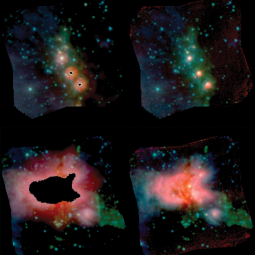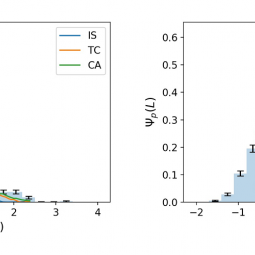By Yingjie Cheng and Joan Schmelz
Paper:
Completing the Protostellar Luminosity Function in Cygnus-X with SOFIA/FORCAST Imaging
Cheng, Yingjie, et al., 2022/05, MNRAS, 512, 960.
Large infrared surveys of molecular clouds have shown consistently that low-mass protostars are less luminous than expected from traditional star-formation models. The solution to this so-called ‘luminosity problem’ would shed light on some fundamental problems like the time required for a low-mass star to form. Since different star formation theories predict different protostellar luminosity functions, probing a large, unbiased sample of protostars could address these issues. Such a study hinges critically on obtaining a complete census of young stellar objects and extending their spectral energy distribution coverage through mid-infrared wavelengths.
The Cygnus X complex, one of the most active nearby star-formation regions, is a promising laboratory for this study. The huge protostar sample as well as the wide range of star-forming environments set the stage for not only completing the aggregate protostellar luminosity function, but also testing how it is affected by natal environment. Over 21,000 point sources have already been detected and identified as young stellar objects within Cygnus X as part of the Spitzer Extended Solar Neighborhood Archive, which provides uniformly produced mosaics, source catalogues, and corresponding completeness maps. However, the capacity of Spitzer to constrain the luminosity of bright sources is largely inhibited by confusion and saturation in its MIPS 24 μm data. In order to obtain the luminosities of bright, closely clustered protostars and in turn complete the luminosity coverage, new observations with the Faint Object InfraRed CAmera for the SOFIA Telescope (FORCAST) instrument on SOFIA are required.
Since the FORCAST beam is much cleaner than the MIPS beam at large radii, its sensitivity gain for bright sources and nebulosity is frequently superior to MIPS. By combining bright protostars identified by FORCAST with the existing Spitzer catalogue, the coverage and luminosity estimates of bright protostars are greatly improved. Furthermore, differences among model predictions are best tested at the high luminosity end, so including the FORCAST data makes the comparison between observations and theories much more feasible.
An empirical relationship based on the mid-infrared spectral index and the mid-infrared luminosity is used to derive the bolometric luminosities of identified protostars. Then the protostellar luminosity function is simply the probability density distribution of the bolometric luminosities of all detected protostars. After accounting for possible contamination and incompleteness, the protostellar luminosity function in Cygnus X is well described by a power-law function with an index of around −0.5.
Previous work argued that the protostellar luminosity function in Cygnus X varies within molecular complexes and depends on the local environment in which protostars form. The improved sample results indicate that the protostellar luminosity function shows no dependence on temperature, but exhibits some excess at higher luminosities in regions of high stellar or gas density. These results are consistent with previous studies.
Researchers compared the observed protostellar luminosity function with predictions from three different models. The isothermal-sphere model assumes that gas accretes from an isothermal gas sphere on to the protostar at a constant rate determined by temperature. The turbulent-core model describes high-mass star formation in which stars form from turbulently supported cores within a gravitationally bound clump of gas. In the competitive-accretion model, stars accrete gas in the same gravitational potential until exhausted or ejected, so the accretion rate of each protostar depends on its mass and location within the clump of gas. The isothermal-sphere model does not reproduce the observed data. The lack of dependence on the gas temperature further supports the rejection of this model. Both the turbulent-core and competitive-accretion models fit the data well for constant accretion rates, but appear to over-predict the low-luminosity end and under-predict the high-luminosity end in regions of higher gas density. This may be an indication that episodic accretion as seen by SOFIA is an important aspect of star formation.

